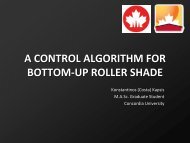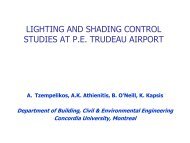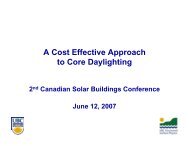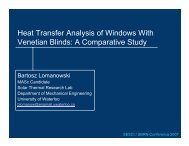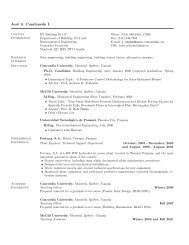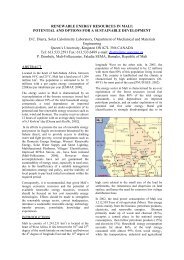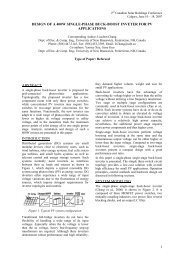The Use of Amorphous Silicon in Fabricating a Photovoltaic-Thermal ...
The Use of Amorphous Silicon in Fabricating a Photovoltaic-Thermal ...
The Use of Amorphous Silicon in Fabricating a Photovoltaic-Thermal ...
Create successful ePaper yourself
Turn your PDF publications into a flip-book with our unique Google optimized e-Paper software.
<strong>The</strong> <strong>Use</strong> <strong>of</strong> <strong>Amorphous</strong> <strong>Silicon</strong> <strong>in</strong><br />
Fabricat<strong>in</strong>g a <strong>Photovoltaic</strong>-<strong>The</strong>rmal<br />
System<br />
Pratish Mahtani, Davit Yeghikyan, Nazir P. Kherani, and<br />
Stefan Zukotynski<br />
Advanced <strong>Photovoltaic</strong>s and Devices Group<br />
Department <strong>of</strong> Electrical and Computer Eng<strong>in</strong>eer<strong>in</strong>g<br />
University <strong>of</strong> Toronto<br />
June 11 th , 2007
Outl<strong>in</strong>e<br />
I. <strong>Photovoltaic</strong>-<strong>The</strong>rmal (PV/T)<br />
Systems<br />
II.<br />
<strong>Amorphous</strong> <strong>Silicon</strong> <strong>in</strong> PV/T Systems<br />
III. Proposed Research<br />
University <strong>of</strong> Toronto
<strong>The</strong>rmal Generation <strong>in</strong> PV<br />
• Convert 60-70% <strong>of</strong> <strong>in</strong>cident radiation to thermal energy<br />
• Can reach 35ºC above ambient [van Helden et al, 2004]<br />
• With <strong>in</strong>creas<strong>in</strong>g temperature:<br />
• I sat <strong>in</strong>creases -> V oc decreases:<br />
• Bandgap decreases -> I sc <strong>in</strong>creases<br />
• Net negative effect on efficiency<br />
• Temperature Coefficients:<br />
• c-Si: -0.4%/ºC [Emery et al, 1996]<br />
• a-Si:H: -0.1%/ºC [Emery et al, 1996]<br />
University <strong>of</strong> Toronto
PV/T System Overview<br />
• Co-generate electricity and heat<br />
• Heat generated from PV extracted by heat exchanger<br />
• Photons transmitted through PV panel (Eph < Eg) absorbed by heat<br />
exchanger<br />
• System configuration:<br />
• covered/uncovered<br />
• air/water<br />
• fluid flow rate<br />
PV panel<br />
heat exchanger<br />
lam<strong>in</strong>ate<br />
adhesive<br />
<strong>in</strong>sulat<strong>in</strong>g frame<br />
Figure 1: Basic covered PV/T system configuration<br />
water / air<br />
flow<br />
University <strong>of</strong> Toronto
Current Status <strong>in</strong> PV/T<br />
• Practical conversion efficiency PV/T (electrical + thermal): 60-<br />
80% [Bergene et al, 1995]<br />
• Research focus on balanc<strong>in</strong>g electrical and thermal efficiencies<br />
• Design trade<strong>of</strong>fs between electrical and thermal efficiency<br />
Table 1<br />
Trade-<strong>of</strong>fs between thermal & electrical efficiency <strong>of</strong> c-Si PV/T [Zondag et al, 2003]<br />
Type<br />
<strong>The</strong>rmal<br />
Efficiency<br />
Electrical<br />
Efficiency<br />
Stand-alone<br />
PV<br />
9.7%<br />
Stand-alone<br />
STC<br />
83%<br />
Covered<br />
PV/T<br />
58%<br />
8.9%<br />
Uncovered<br />
PV/T<br />
52%<br />
9.7%<br />
University <strong>of</strong> Toronto
PV/T Issues<br />
• Reduced thermal efficiency:<br />
• PV/T collected 33% less thermal energy than STC [Zondag et al, 2002]<br />
• High Emissivity <strong>of</strong> PV Module:<br />
• PV lam<strong>in</strong>ates ~ 90% emissive <strong>in</strong> IR [Zondag et al, 2004]<br />
• Low-E coat<strong>in</strong>gs low transmission <strong>in</strong> visible spectrum (60-70%) [van Helden et<br />
al, 2004]<br />
• Lower <strong>in</strong>cident radiation on STC:<br />
• PV conversion<br />
• Reflective back rear foil<br />
• AR coat<strong>in</strong>g not optimized for IR radiation<br />
• Reduced electrical efficiency:<br />
• PV temperature covered PV/T 20ºC higher than stand-alone PV<br />
[Sandnes et al, 2002]<br />
• Higher Cost:<br />
• 1m 2 PV/T costs $(CAN)29 MORE than 1m 2 PV + 1m 2 STC<br />
[Bakker et al, 2005]<br />
University <strong>of</strong> Toronto
a-Si:H PV/T<br />
• Lower cost<br />
• Improved high-temperature performance<br />
• Staebler-Wronksi Effect<br />
• Positive Temperature Coefficient<br />
• Improved thermal efficiency<br />
University <strong>of</strong> Toronto
Lower Cost<br />
c-Si PV:<br />
• Cyl<strong>in</strong>drical <strong>in</strong>gots from molten Si<br />
• New c-Si “th<strong>in</strong>-film” deposition temperature: 800ºC-1400ºC [B.P. Nelson et<br />
al, 2003]<br />
• Metals have high thermal exp. and low melt<strong>in</strong>g po<strong>in</strong>t<br />
a-Si:H th<strong>in</strong>-film PV:<br />
• Can be deposited over large areas at low temperatures (
Staebler-Wronski Effect<br />
• a-Si:H PV suffers from light-<strong>in</strong>duced degradation - Staebler-Wronksi<br />
Effect (SWE)<br />
• Exposure to light <strong>in</strong>creases defect density<br />
• Increase defect density leads to <strong>in</strong>crease <strong>in</strong> recomb<strong>in</strong>ation current and<br />
decrease <strong>in</strong> efficiency<br />
• Effect saturates after 1000h <strong>of</strong> light exposure with efficiency level<strong>in</strong>g <strong>of</strong>f<br />
at 30% lower than <strong>in</strong>itial efficiency [Luque et al, 2003]<br />
• SWE can be reversed by anneal<strong>in</strong>g at T ~ 150°C for few m<strong>in</strong>utes [Luque<br />
et al, 2003]<br />
University <strong>of</strong> Toronto
Temperature Coefficient<br />
• a-Si:H PV temperature coefficient:<br />
• short-term: -0.1%/ºC [Emery et al, 1996]<br />
• if kept at high temperature: +0.5%/ºC [Luque et al, 2003]<br />
• a-Si:H PV module case study:<br />
• module kept at 60ºC dur<strong>in</strong>g daylight hours generated 20% more<br />
energy than module kept at 35ºC [H<strong>of</strong> et al, 1996]<br />
• Attributed to slow, low-temperature anneal <strong>of</strong> SWE [Luque et<br />
al, 2003]<br />
• Alleviates thermal-electrical trade<strong>of</strong>f<br />
University <strong>of</strong> Toronto
Improved <strong>The</strong>rmal Efficiency<br />
Increased Incident Radiation:<br />
• Direct deposition onto STC <strong>in</strong>creases <strong>in</strong>cident radiation onto STC<br />
Lower Emissivity:<br />
• Us<strong>in</strong>g low emissivity PV cells will reduce significance <strong>of</strong> highly emissive lam<strong>in</strong>ate<br />
• PV emissivity:<br />
• c-Si: 40% [Platz et al, 1997]<br />
• a-Si:H: 30% [Affolter et al, 2000]<br />
• Commercial low-E coat<strong>in</strong>gs used <strong>in</strong> STC:
Proposed Research<br />
• Develop<strong>in</strong>g and model<strong>in</strong>g a-Si:H PV<br />
directly deposited on STC<br />
• Research Focus:<br />
• Lower cell emissivity<br />
• Cell <strong>in</strong>terconnection<br />
University <strong>of</strong> Toronto
Lower Cell Emissivity<br />
• Replace p-type a-Si:H layer with p-type a-C:H<br />
• a-C:H/Ti films used as low-E coat<strong>in</strong>g for STC<br />
• IR Emittance (100ºC): 6% [Schuler et al, 2000]<br />
• a-C:H acts as w<strong>in</strong>dow layer and helps <strong>in</strong>crease PV efficiency<br />
• Eg <strong>of</strong> p-type a-C:H: 2.0eV [Han et al, 2007]<br />
• Eg <strong>of</strong> p-type a-Si:H: 1.7eV [Han et al, 2007]<br />
• Efficiency <strong>in</strong>creased from 5.1% to 5.6% [Han et al, 2007]<br />
p-type a-Si:H<br />
i-type a-Si:H<br />
n-type a-Si:H<br />
h+<br />
e-<br />
E<br />
p-type a-C:H<br />
i-type a-Si:H<br />
n-type a-Si:H<br />
(a)<br />
(b)<br />
Figure 4: (a) conventional a-Si:H p-i-n design (b) a-C:H w<strong>in</strong>dow layer design<br />
h+<br />
e-<br />
h+<br />
e-<br />
E<br />
University <strong>of</strong> Toronto
Cell Interconnection<br />
• <strong>The</strong>rmally conductive, electrically <strong>in</strong>sulative materials (TCEI):<br />
• Al 2<br />
0 3<br />
: ρ = 10 16 Ωm [Dickey et al, 1989] κ= 30Wm -1 k -1 [Ogden et al, 1987]<br />
• Al: ρ = 2.82X10 -8 Ωm [Serway et al, 1998] κ= 205 Wm -1 k -1 [Sears et al, 1987]<br />
• Glass: ρ= 10 14 Ωm [Serway et al, 1998], κ= 0.8 Wm -1 k -1 [Sears et al, 1987]<br />
• Monolithic Design:<br />
• Entire module fabricated directly on STC<br />
• Interconnection made by laser weld<strong>in</strong>g [Vijh et al, 2006]<br />
• Slab Design:<br />
• Cut large area cell <strong>in</strong>to smaller cells<br />
• Cells adhered to STC<br />
front contacts<br />
laser<br />
weld<br />
a-Si:H<br />
STC<br />
(a)<br />
front contacts<br />
TCO<br />
back contacts<br />
TCEI<br />
TCO<br />
a-Si:H<br />
TCEI<br />
STC<br />
(b)<br />
TCO<br />
a-Si:H<br />
metallic<br />
foil<br />
adhesive<br />
Figure 5: (a) monolithic design (b) slab design<br />
University <strong>of</strong> Toronto
Summary<br />
• PV/T utilizes <strong>in</strong>tr<strong>in</strong>sic losses <strong>in</strong> PV devices<br />
• PV/T Issues:<br />
• manufactur<strong>in</strong>g cost<br />
• PV efficiency at high temperatures<br />
• lower absorption and higher emittance than stand-alone STC<br />
• a-Si:H for PV/T:<br />
• th<strong>in</strong>-film direct deposition<br />
• strong high temperature performance<br />
• lower emittance than c-Si cells<br />
• Research at U<strong>of</strong>T:<br />
• cell Interconnection<br />
• decrease PV emittance<br />
University <strong>of</strong> Toronto
Acknowledgements<br />
• Dr. Steve Harrison<br />
• Jarrett Carriere<br />
• Advanced <strong>Photovoltaic</strong>s and Devices Group<br />
• SBRN<br />
University <strong>of</strong> Toronto
References<br />
Affolter, P., Ruoss, D., Toggweiler, P., Haller, A., 2000. “New generation <strong>of</strong> Hybrid Solar PV/T<br />
collectors”, EPFL.<br />
Bakker, M., Zondag, H.A., Elsijk M.J., Strootman, K.J., Jong M.J.M., 2005. “Performance and<br />
costs <strong>of</strong> a ro<strong>of</strong>-sized PV/thermal array comb<strong>in</strong>ed with a ground couple heat pump”, Solar<br />
Energy, vol. 78, pp. 331.<br />
Bergene, T., Lovvik, O.M., 1995. “Model calculations on a flat-plate solar heat collector with<br />
<strong>in</strong>tegrated solar cells”, Solar Energy, vol. 55., pp. 453.<br />
Dickey, J.R., Davidson, J.L., and Tzeng, Y., 1989., “Improved dielectric properties <strong>of</strong> anodic<br />
alum<strong>in</strong>um oxide films by s<strong>of</strong>t/hard two-step electrolytic anodization”, J. Electrochem. Soc.,<br />
vol. 136. no. 6.<br />
Emery, K., Burdick, J. Calyem, Y., Dunlavy, D., Field, H., Kroposki, B., Moriary, T., Ottoson, L.,<br />
Rummel, S., Strand T., Wanlass M., 1996. “Temperature dependence <strong>of</strong> photovoltaic cells,<br />
modules and systems”, Proceed<strong>in</strong>gs <strong>of</strong> 25th <strong>Photovoltaic</strong> Specialists Conference, pp. 1275.<br />
University <strong>of</strong> Toronto
References<br />
Gell<strong>in</strong>, K., Roos, A., Geotti-Bianch<strong>in</strong>i, F., van Nijnatten, P., 2005. “<strong>The</strong>rmal emissivity <strong>of</strong> coated<br />
glaz<strong>in</strong>g – simulation versus measurements”. Optical Materials, vol 27, pp. 705.<br />
Han, J., Tan, M., Zhu, J., Meng, S., Wang, B., Mu, S., Cao, D., 2007. “<strong>Photovoltaic</strong><br />
characteristics <strong>of</strong> amorphous silicon solar cells us<strong>in</strong>g boron doped tetrahedral amorphous<br />
carbon films as p-type w<strong>in</strong>dow materials”, Applied Physics Letters, vol. 90.<br />
H<strong>of</strong>, C., Ludii, M., Goetz, M., Fischer, D., Shah, A., 1996. “Long term behaviour <strong>of</strong> passively<br />
heated or cooled a-Si:H modules”, Proceed<strong>in</strong>gs <strong>of</strong> 25th <strong>Photovoltaic</strong> Specialists<br />
Conference, pp. 1057.<br />
Luque, A., Hegedus, S., 2003. Handbook <strong>of</strong> <strong>Photovoltaic</strong> Science and Eng<strong>in</strong>eer<strong>in</strong>g, West<br />
Sussex: Wiley.<br />
Nelson, B.P, Atwater, H.A., von Roedern, B., Yang, J., Sims, P. Deng, X., Dalal, V., Carlson, D.,<br />
Wang, T., 2003. “<strong>Amorphous</strong> and Th<strong>in</strong>-Film <strong>Silicon</strong>”, NREL.<br />
University <strong>of</strong> Toronto
References<br />
Ogden, T.R., Rathsam, A.D., Gilchrist, J.T., “<strong>The</strong>rmal conductivity <strong>of</strong> thick anodic oxide coat<strong>in</strong>gs<br />
on alum<strong>in</strong>um”, 1987. Materials Letters. vol. 5, no. 3.<br />
Platz, R., Fischer, D., Zufferey, M.A., Selven, J.A., Haller, A., Shah, A., 1997. “Hybrid collectors<br />
us<strong>in</strong>g th<strong>in</strong>-film technology”, Proceed<strong>in</strong>gs <strong>of</strong> 26th <strong>Photovoltaic</strong>s Specialists Conference, pp.<br />
1293.<br />
Sandnes, B., Rekstad, J., 2002. “A photovoltaic/thermal (PV/T) collector with a polymer<br />
absorber plate. Experimental study and analytical model”, Solar Energy, vol. 72. iss. 1, pp.<br />
63.<br />
Schuler, A., Geng, J., Oelhafen, P., Brunold S., Gantenbe<strong>in</strong>, P., Frei, U., 2000. “Application <strong>of</strong><br />
titanium conta<strong>in</strong><strong>in</strong>g amorphous hydrogenated carbon films (a-C:H/Ti) as optical selective<br />
solar absorber coat<strong>in</strong>gs”, Solar Energy Materials, vol. 60, pp. 295.<br />
Sears, F.W., Zemansky, M.W., Young, H.D., 1987: University Physics, 7th Ed. Read<strong>in</strong>g, MA:<br />
Addison-Wesley Publish<strong>in</strong>g Company<br />
Serway, Raymond A., 1998. Pr<strong>in</strong>ciples <strong>of</strong> Physics, 2nd ed, Fort Worth, Texas; London:<br />
Saunders College Pub<br />
University <strong>of</strong> Toronto
References<br />
van Helden, W.G.J., van Zol<strong>in</strong>gen, R.J.C., Zondag, H.A., 2004. “PV <strong>The</strong>rmal Systems: PV<br />
Panels Supply<strong>in</strong>g Renewable Electricity and Heat”, Prog. Photovolt: Res. and Appl., Vol. 12,<br />
pp.415-426.<br />
Vijh, A., Yang, X., Du, W., Deng, X., 2006. “Triple-junction amorphous silicon-based flexible<br />
solar m<strong>in</strong>imodule with <strong>in</strong>tegrated <strong>in</strong>terconnects”, Solar Energy Materials and Solar Cells, vol.<br />
90, pp. 2657.<br />
Zondag, H.A., De Vries, D.W., van Helden, W.G.J., van Zol<strong>in</strong>gen, R.J.C., van Steenhoven, A.A.,<br />
2002. “<strong>The</strong> thermal and electrical yield <strong>of</strong> a PV-<strong>The</strong>rmal collector”, Solar Energy, Vol. 72,<br />
No. 2.<br />
Zondag, H.A., De Vries, D.W., van Helden, W.G.J., van Zol<strong>in</strong>gen, R.J.C., van Steenhoven, A.A.,<br />
2003. “<strong>The</strong> yield <strong>of</strong> different comb<strong>in</strong>ed PV-thermal collector designs”, Solar Energy, Vol. 74,<br />
No. 3.<br />
Zondag, H.A., van Helden, W.G.J., Elswijk, M.J., Bakker, M., 2004. “PV-<strong>The</strong>rmal collector<br />
development – an overview <strong>of</strong> the lessons learnt”, Proceed<strong>in</strong>gs <strong>of</strong> the 19th European PV<br />
Solar Energy Conference and Exhibition”, pp. 7.<br />
University <strong>of</strong> Toronto
Thank you for your attention!<br />
Any Questions or Comments?<br />
University <strong>of</strong> Toronto


